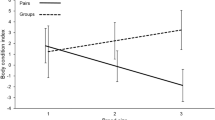Summary
Previous studies of food allocation among nestlings of siblicidal birds have focussed on the proximate link between food and aggression. However, food sharing among sibs (and brood reduction) need not involve aggression. Here I examine the role of hunger (defined operationally in terms of the amount of food eaten recently) within the broader framework of passive and aggressive food-sharing among nestlings of facultatively siblicidal ospreys (Pandion haliaetus). Feeding among brood members was hierarchical; senior, dominant sibs ate more when hungry, leaving a smaller residual share of food for junior sibs. Senior sibs did not become more generous at large meals (i.e., the prospect of a large meal did not quell the selfish tendencies of senior sibs). That individuals ate more when hungry indicates a proximate link between food and the allocation of resources among siblings. Overall, aggression was infrequent and seemed to be used when junior sibs contested food allocation at meals. Aggression was diminished and food allocation was skewed toward the junior sib in broods with artificially exaggerated hatching intervals, suggesting that senior sibs were more generous when their dominant status was not threatened.
Similar content being viewed by others
References
Braun BM, Hunt GL Jr (1983) Brood reduction in black-legged kittiwakes. Auk 100:469–476
Cash K, Evans RM (1986) Brood reduction in the American white pelican (Pelecanus erythrorhynchos). Behav Ecol Sociobiol 18:413–418
Drummond H, Garcia Chavelas C (1989) Food shortage influences sibling aggression in the blue-footed booby. Anim Behav 37:806–819
Drummond H, Gonzalez E, Osorno J (1986) Parent-offspring cooperation in the blue-footed booby (Sula nebouxii): social roles in infanticidal brood reduction. Behav Ecol Sociobiol 19:365–372
Fujioka M (1985) Feeding behaviour, sibling competition, and siblicide in asynchronous hatching broods of the cattle egret Bubulcus ibis. Anim Behav 33:1228–1242
Gargett V (1978) Sibling aggression in the black eagle in the Matopos, Rhodesia. Ostrich 49:57–63
Garnett MC (1981) Body size, its heritability and influence on juvenile survival among great tits Parus major. Ibis 123:31–41
Hurlbert SJ (1984) Pseudoreplication and design of ecological field experiments. Ecol Monogr 54:187–211
Jarvis MJF (1974) The ecological significance of clutch size in the South African gannet (Sula capensis Lichtenstein). J Anim Ecol 43:1–17
Krementz DG, Nichols JD, Hines JE (1989) Postfledging survival of European starlings. Ecology 70:646–655
Lack D (1954) The natural regulation of animal numbers. Oxford University Press
Mock DW (1984) Siblicidal aggression and resource monopolization in birds. Science 225:731–733
Mock DW, Ploger BJ (1987) Role of sibling aggression in distribution of food to nestling cattle egrets (Bubulcus ibis). Auk 103:768–776
Mock DW, Lamey TC, Ploger BJ (1987) Proximate and ultimate roles of food amount in regulating egret sibling aggression. Ecology 68:1760–1772
Neter J, Wasserman W, Kutner MH (1985) Applied linear statistical models. Irwin, Homewood, IL
Parker GA, Mock DW, Lamey TC (1989) How selfish should stronger sibs be? Am Nat 133:846–868
Perrins CM (1963) Survival in the great tit Parus major. Proc Int Ornithol Congress XIII:717–728
Ploger BJ, Mock DW (1986) Role of sibling aggression in the distribution of food to nestling cattle egrets (Bubulcus ibis). Auk 103:768–776
Poole AF (1979) Sibling aggression among nestling ospreys in Florida Bay. Auk 96:415–416
Poole AF (1982) Brood reduction in temperate and subtropical ospreys. Oecologia 53:111–119
Poole AF (1984) Reproductive limitation in coastal ospreys: an ecological and evolutionary perspective. PhD thesis, Boston University, MA
Poole AF (1989) Ospreys. Cambridge University Press, NY
Procter DLC (1975) The problem of chick loss in the south polar skua Catharacta maccormicki. Ibis 117:452–459
Steeger C (1989) Proximate and ultimate aspects of seasonal variation in the reproductive performance of ospreys. MSc thesis, Simon Fraser University, Burnaby, BC
Author information
Authors and Affiliations
Additional information
Offprint requests to the present address
Rights and permissions
About this article
Cite this article
Forbes, L.S. Hunger and food allocation among nestlings of facultatively siblicidal ospreys. Behav Ecol Sociobiol 29, 189–195 (1991). https://doi.org/10.1007/BF00166400
Received:
Accepted:
Issue Date:
DOI: https://doi.org/10.1007/BF00166400




